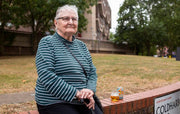
The Accidental Brutalist: Magda Borowiecka
September 2, 2020
As part of our series, Characters of Coldharbour Lane, raising a glass to the people and places along Coldharbour Lane, Barrier Block architect, Magda Borowiecka spoke to us about her extraordinary life and career, and the only thing she likes about her best-known building.
Anyone who’s ever walked along Coldharbour Lane between Atlantic Road and Valentia Place for the first time can’t help but wonder about the enormous monolith of brick and concrete, with its tiny windows and looming façade, like a Soviet-era sports hall crash landed in the middle of an otherwise Victorian stretch of Brixton. It is not Brixton Prison, which is what newcomers often assume. It is Southwyck House or, as it’s much more commonly known, the Barrier Block.
Its unique form was designed to withstand the noise and pollution of a gigantic raised flyover that would have cut through the heart of Brixton. Fortunately, this plan was abandoned in the early 1970s. Rumours about the block have circulated for years, such as that it was built the wrong way around. But perhaps the most persistent rumour, the one that still pops up close to the top of Google searches and persists in local urban legend, is that the architect was so distressed by public criticism of her work that she committed suicide.
In fact, Magda Borowiecka is fast approaching her 90th birthday and still lives in Lambeth. We got in touch by emailing her son, also an architect, who said that if beer was involved, Magda would be delighted to speak to us. We sat down for a Coldharbour Lager to hear more about her fascinating life and her most famous design.
Q: Why did your parents leave Poland and bring you to the UK?
A: My parents were from Warsaw and they left just before the war when it looked like Poland wasn’t going to hold up as my father worked for the Ministry of Internal Affairs. We came to the UK and I was sent to a boarding school in Scotland.
Q: How did you become an architect?
A: I decided that when I was 11 that I wanted to be an architect. All the other girls in school wanted to be secretaries and nurses and nannies and things like that and I remember them asking, “what does an architect do?” and I said, “designs houses”. They were impressed so that was that! I stuck with it.
It was still war time back then so everything was a bit different. It meant that even though I was only 15 I was allowed to sit the architecture exam. I left with a little slip saying I was good enough to start studying so I came to London and completed my training.
Q: How did you end up being the lead architect for the infamous Barrier Block?
A: I knew that I wanted to work for Lambeth Council because at the time there was a big plan to rebuild Clapham Town which I liked the idea of. So I applied for a job and I got it, but then they didn’t put me on the Clapham project, instead they said, we have something more exciting for you.
On the council at that time there were six different architecture teams, with 15 people in each, and it quickly became clear that none of them wanted to be landed with this new project.
I was given the brief, and the truth is it was very daunting. I was terrified of the whole thing.

Q: The estate is technically called Southwyck House but when did it get the nickname ‘barrier block’?
A: It was obvious that we had to build something high to be a barrier to the motorways, I probably used it first!
Q: What challenges did you face?
A: It was a lot of work and my children were born while I worked on the project so I was very busy!
When I arrived they gave me a year to complete the planning. Nobody had done anything like this before so the first thing I had to do was learn all about noise control. The main thing seemed to be to be to put a barrier as close to the actual source of the noise as possible. I wrote a letter to Ministry of Transport and said, ‘will you help us by putting up a sound barrier?’ They said no, even when I offered to give them some of my budget to work with.
It took a lot of time to get everything signed off. We needed to satisfy our boss, the planners, and the council. It was an enormous amount of work to get the plans completed- everything was by hand back then- but we did it. At the end of the year we were ready to go out to tender for a contractor.
Then suddenly they cancelled the motorway and the big question was, what do we do? We only had a limited amount of time to spend our budget for the project or we’d lose it and have to start again. At the time Lambeth was under John Major’s Conservative control. We asked him what to do. He’d only just started on the council and probably felt it was better to go ahead with things than not, so it was his decision to start building.
He later wrote a big article in the Daily Telegraph all about the dreadful things the council were building, naming the most dreadful of all as the Barrier Block.
I found it all very difficult at the time and the only thing that kept me going was that the group had several schemes not just one, and there was a project on Dunbar Street [the Dunbar Dunelm Estate in West Norwood] which I worked on and am very proud of.
Q: How did you come up with the design?
A: We were not able to change the design at all even after we knew the motorway would not be built.
The small windows were designed to help with the noise and pollution from the motorway, and we had all the bathrooms on the outside of the building so the living space would be away from the road.
And we had all this blank wall, which is why I came up with the idea to add a pattern. The zig zag pattern is the one thing I’m proud of in the whole building. [Incidentally, this is the feature that inspired our Coldharbour Lager cans - more about that here!]

Q: How was the building received?
A: Everybody hated it. I mean everybody hated it. And that was at the time when they were cancelling all the architecture work by the councils, so I was given the boot in fact after the project. I got early retirement so I didn’t mind! I did continue to do odd jobs but not for the council.

Q: Is it frustrating that you’re best known for a project you don’t like?
Certainly it’s frustrating. But this abstract elevated style of architecture eventually became fashionable. Examples of Brutalist architecture in London, like the Southbank, were celebrated, and the Barrier Block started to be considered in that category. They included me in that movement even though it was never my intention. So I became a Brutalist architect by accident.
Q: Have your feelings towards the Barrier Block changed?
That was ten years of my life – all that work! But I still don’t like it. It would have been alright if it had done its job. The shame is that it isn’t doing the job that it was designed to do.
At this point in the interview, we suggested that we walk Magda over for a portrait in front of her now iconic creation. She gently but firmly pointed out that she hadn’t yet finished her beer, and the portrait would have to wait. We never did ask her if she knew of the rumours of her death; we make beer, not hard-hitting journalism that may be upsetting to pioneering architects. Besides, given she was seated in front of us, enjoying a Coldharbour Lager and a rousing conversation at 11am, it seemed obvious that these rumours had been greatly exaggerated.
Portraits from our Characters of Coldharbour Lane series will be on display at the Brixton Brewery Tap Room from 23rd September or you can see them as they drop on Instagram @brixtonbrewery. Look for Coldharbour Lager at bars and bottle shops throughout London and beyond (or shop via our website here). Grab one and take refuge from thirst.
Sign up for the latest news, brews and offers from Team BB
Send me personalised offers and news about the Brixton Brewery brand via email and online targeted adverts. Brixton Brewery Limited will process your data in accordance with our Privacy Policy. You can withdraw consent by clicking unsubscribe in any email or emailing protectyourdata@brixtonbrewery.com.



